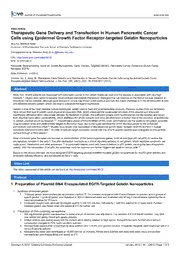
Therapeutic Gene Delivery and Transfection in Human Pancreatic Cancer Cells using Epidermal Growth Factor Receptor-targeted Gelatin Nanoparticles. PDF
Preview Therapeutic Gene Delivery and Transfection in Human Pancreatic Cancer Cells using Epidermal Growth Factor Receptor-targeted Gelatin Nanoparticles.
JournalofVisualizedExperiments www.jove.com VideoArticle Therapeutic Gene Delivery and Transfection in Human Pancreatic Cancer Cells using Epidermal Growth Factor Receptor-targeted Gelatin Nanoparticles Jing Xu,Mansoor Amiji DepartmentofPharmaceuticalSciences,SchoolofPharmacy,NortheasternUniversity Correspondenceto:[email protected] URL:http://www.jove.com/video/3612/ DOI:10.3791/3612 Keywords:Bioengineering,Issue59,GelatinNanoparticle,GeneTherapy,TargetedDelivery,PancreaticCancer,EpidermalGrowthFactor Receptor,EGFR, DatePublished:1/4/2012 Citation:Xu, J.,Amiji, M. TherapeuticGeneDeliveryandTransfectioninHumanPancreaticCancerCellsusingEpidermalGrowthFactor Receptor-targetedGelatinNanoparticles.J.Vis.Exp.(59),e3612,DOI:10.3791/3612(2012). Abstract Morethan32,000patientsarediagnosedwithpancreaticcancerintheUnitedStatesperyearandthediseaseisassociatedwithveryhigh mortality1.Urgentneedexiststodevelopnovelclinically-translatabletherapeuticstrategiesthatcanimproveonthedismalsurvivalstatisticsof pancreaticcancerpatients.Althoughgenetherapyincancerhasshownatremendouspromise,themajorchallengeisinthedevelopmentofsafe andeffectivedeliverysystem,whichcanleadtosustainedtransgeneexpression. Gelatinisoneofthemostversatilenaturalbiopolymer,widelyusedinfoodandpharmaceuticalproducts.Previousstudiesfromourlaboratory haveshownthattypeBgelatincouldphysicalencapsulateDNA,whichpreservedthesupercoiledstructureoftheplasmidandimproved transfectionefficiencyuponintracellulardelivery.Bythiolationofgelatin,thesulfhydrylgroupscouldbeintroducedintothepolymerandwould formdisulfidebondwithinnanoparticles,whichstabilizesthewholecomplexandoncedisulfidebondisbrokenduetothepresenceofglutathione incytosol,payloadwouldbereleased2-5.Poly(ethyleneglycol)(PEG)-modifiedGENS,whenadministeredintothesystemiccirculation,provides long-circulationtimesandpreferentiallytargetstothetumormassduetothehyper-permeabilityoftheneovasculaturebytheenhanced permeabilityandretentioneffect6.Studieshaveshownover-expressionoftheepidermalgrowthfactorreceptor(EGFR)onPanc-1human pancreaticadenocarcinomacells7.Inordertoactivelytargetpancreaticcancercellline,EGFRspecificpeptidewasconjugatedontheparticle surfacethroughaPEGspacer.8 Mostanti-tumorgenetherapiesarefocusedonadministrationofthetumorsuppressorgenes,suchaswild-typep53(wt-p53),torestorethe pro-apoptoticfunctioninthecells9.Thep53mechanismfunctionsasacriticalsignalingpathwayincellgrowth,whichregulatesapoptosis,cell cyclearrest,metabolismandotherprocesses10.Inpancreaticcancer,mostcellshavemutationsinp53protein,causingthelossofapoptotic activity.Withtheintroductionofwt-p53,theapoptosiscouldberepairedandfurthertriggerscelldeathincancercells11. Basedontheaboverationale,wehavedesignedEGFRtargetingpeptide-modifiedthiolatedgelatinnanoparticlesforwt-p53genedeliveryand evaluateddeliveryefficiencyandtransfectioninPanc-1cells. VideoLink Thevideocomponentofthisarticlecanbefoundathttp://www.jove.com/video/3612/ Protocol 1. Preparation of Plasmid DNA Encapsulated EGFR-Targeted Gelatin Nanoparticles 1. Synthesisofthiolatedgelatin 1. Thiolatedgelatinweresynthesizedaspreviousmethod2-5,bycovalentconjugationwith2-iminothiolaneonprimaryaminogroupsof typeBgelatin.1gramofgelatinwasdissolvedin100mldeionizedwaterandincubatedwith20mg2-iminothiolanehydrochlorideat roomtemperaturefor15hours. 2. Unreactedreagentwasremovedbydialysisagainst5mMHClsolution,followedby1mMHClsolutionfor3hourseach.Purified thiolatedgelatinwasfreezedriedandstoredat4°Cforfurtheruse. 2. PreparationofDNA-containingnanoparticles 1. 200mgthiolatedgelatinwasdissolvedinwaterandpHofsolutionwasadjustedto7byadditionof0.2MNaOHsolution.1mgDNA wasaddedandgentlymixedwithgelatinsolution. 2. Chilledethanolwasaddedslowlyintothemixturewhilestirringsolutionathighspeed.Nanoparticleswereformedwhensolvent compositionchangedto75%hydro-alcoholicsolution. 3. Nanoparticleswerefurthercrosslinkedbyslowadditionof0.1ml8%(v/v)glyoxalsolution.Unreactedreagentswerequenchedwith0.5 ml0.2Mglycinesolution. 4. Nanoparticleswereultra-centrifugedat16,000rpmfor30minutes.Pelletswerewashedwithdeionizedwatertwiceandpurified nanoparticleswerefreeze-driedandstoredat4°C. Copyright©2012 CreativeCommonsAttributionLicense January2012| 59 |e3612|Page1of9 JournalofVisualizedExperiments www.jove.com 3. Surfacemodificationofnanoparticles 1. Nanoparticlesweresuspendedin0.1Mphosphatebuffer(pH7.4)withconcentrationof10mg/mlandincubatedwith2timesweightof methoxy-PEG-succinimidylcarboxymethylester(mPEG-SCM,MW2,000Da)ormaleimide-PEG-succinimidylcarboxymethylester (MAL-PEG-SCM,MW2,000Da)for2hoursatroomtemperaturewithslowstirring. 2. PEGylatednanoparticleswerecollectedwithultra-centrifugationat16,000rpmfor30minutes.Pelletswerewashedwithdeionized watertwiceandpurifiednanoparticleswerefreeze-driedandstoredat4°C. 3. MAL-PEG-SCMmodifiednanoparticlesweresuspendedin0.1Mphosphatebuffer(pH6.5)withconcentrationof10mg/mland incubatedwith10%weightofEGFRspecificpeptide(Y-H-W-Y-G-Y-T-P-Q-N-V-I-G-G-G-G-C)for6hoursatroomtemperaturewithslow stirring. 4. Peptidemodifiednanoparticleswerecollectedwithultra-centrifugationat16,000rpmfor30minutes.Pelletswerewashedwith deionizedwatertwiceandpurifiednanoparticleswerefreeze-driedandstoredat4°C. 2. Characterization of EGFR-Targeted Nanoparticles 1. Particlesizeandzetapotentialmeasurement Nanoparticlesweresuspendedinwaterwithconcentrationof1mg/ml.SuspensionwasanalyzedusingZetasizerNano(MalvernInc).Particle sizeanalysiswascarriedoutatascatteringangleof90degreesat25°C.Zetapotentialwasmeasuredatdefaultparametersofdielectric constant,refractiveindexandviscosityofwaterat25°C. 2. ScanningElectronMicroscopy Lyophilizednanoparticlesweremountedonaluminumsamplemountandsputter-coatedwithpalladiumtoenhanceconductivityandminimize buildupofcharges.SampleswereobservedforsurfacemorphologyunderaHitachi4800fieldemissionscanningelectronmicroscopeat3 kV. 3. Electronspectroscopeforchemicalanalysis(ESCA) Freeze-driedformulationofcontrol,PEGylatedandpeptidemodifiednanoparticleswereanalyzedbyESCA.ItwasperformedattheNational ESCAandSurfaceAnalysisCenterforBiomedicalProblems(NESAC/BIO),UniversityofWashington(Seattle,WA). 1. Sampleswereplacedinultrahighvacuumandexposedtolow-energyx-raybeam,whichinducedanemissionofsecondary photoelectronsfromthesurface. 2. Byplottingnumberofdetectedelectronsasafunctionofbindingenergy,observedspectrumpeakswereassignedtoeachchemical components. 3. High-resolutionanalysisofC1sspectrawasperformedtodetermineexactchemicalcompositionfromhydrocarbon(C-CorC-Hat 285mV),ether(C-O)at286.4mV),andcarbonyl(C=Oat288.1mV),andrelativecompositionofeachfunctionalitywasdeterminedby areaundercurve. 4. Stabilityofencapsulatedplasmid ThestabilityoftheencapsulatedplasmidDNAwasconfirmedbyrunningtheextractedDNAonpre-castgels.Thenanoparticleswere digestedwith0.2mg/mlproteasecontainingPBS(30minat37°C)and0.2U/mlDNAse(10minatroomtemperature)separately, simultaneouslyorsequentially.Sampleswerethenloadedonto1.2%agarosegel(GP)(E-Gel,Invitrogen,CA)ataconcentrationof 100ng/wellina18μLvolumeperwell.Nakedplasmidwasloadedascontrolandgelwasrunat75Vfor30minutes.KodakDigitalX-ray Specimen(DXS)SystemwasusedtovisualizebandswithUVtransluminescence. 5. Determinationofplasmidloading Plasmidencapsulatednanoparticlesweresuspendedat1mg/mlanddigestedwith0.2mg/mlproteaseat37°Cfor30minutes.Solutionwas centrifugedat13,000rpmfor10minutesandsupernatantwascollectedandtestedforplasmidconcentrationwithPicogreenassay (Invitrogen).Encapsulationratiowascalculatedbydividingtheencapsulatedplasmidconcentrationwiththeinitialloading0.5%(w/w). 3. In Vitro Transfection Studies in Panc-1 Pancreatic Cancer Cells 1. Cellcultureconditions Panc-1andCapan-1pancreaticadenocarcinomacelllines,SKOV3ovarianadenocarcinomacelllineandNIH-3T3murinefibroblastcellline wereobtainedfromATCC.Panc-1andNIH-3T3weregrownwithDMEMsuppliedwithL-glutamine,Pen-strepand10%fetalbovineserumat 37°Cand5%CO2,whileCapan-1requiredDMEMsupplied20%fetalbovineserum.SKOV3wasgrowninRPMI-1640suppliedwith10% fetalbovineserum. 2. WesternblotanalysisforEGFRexpression 1. Celllysateswerecollectedfrom2millioncellsandanalyzedfortotalproteinconcentrationusingBCAassay(Pierce).NIH-3T3was usedasnegativecontrolandSKOV3wasusedaspositivecontrolforEGFRexpression. 2. 10μgoftotalproteinextractwasrunonpre-castsodiumdodecylsulfate-polyacrylamidegelelectrophoresis(SDS-PAGE)systemat 135Vfor90minutes. 3. Subsequently,gelwastransferredontoPVDFmembranebyiBlotDryBlottingSystem(Invitrogen). 4. Membranewasblockedwith5%non-fatmilkinTween-containingTrisbuffersaline(TBS-t)for1houratroomtemperature. 5. Membranewascutandincubatedwith1:1,000dilutionofprimaryrabbitbeta-actinantibodiesand1:1,000dilutionofprimaryrabbit EGFRantibodiesseparatelyovernightat4°C. 6. MembranewasthenwashedtwicewithTBS-tandincubatedwith1:2,000dilutionsofsecondaryanti-rabbithorse-radish peroxidase-conjugatedIgGinTBS-tfor1houratroomtemperature. 7. AfterrinsingexcessantibodieswithTBS-tandwater,4mlECLsubstrate(Pierce,Rockford,IL,USA)wasaddedandincubatedwith membranesfor5minutes. 8. ChemiluminescentbandswerethenvisualizedusingKodakDigitalX-raySpecimen(DXS)System. 3. Cellviabilitystudieswithdifferentformulations 1. Panc-1cellsweregrownin96-wellplatesat10,000cellsperwellin200μLofsupplementedDMEMovernight. Copyright©2012 CreativeCommonsAttributionLicense January2012| 59 |e3612|Page2of9 JournalofVisualizedExperiments www.jove.com 2. Growthmediumwasreplacedwithserumfreemediacontainingdifferentconcentrationsofnanoparticleswith0,0.5,1,2,4,6mg/ml. 1mg/mlPEI,aknowncytotoxiccationicpolymer,wasusedaspositivecontrol. 3. Cellsweretreatedwith200μLnanoparticlesfor6hoursandthenreplacedwith20μLMTSreagentand100μLcompleteculturemedia. 4. Afterpostincubationfor3hoursat37°Cin5%CO2,theabsorbanceofformazanproductwasmeasuredat490nmwithBiotek SynergyHTplatereader(Winooski,VT). 5. Thepercentviabilityofcellswasexpressedastheratioofabsorbanceofpolymertreatedcellsrelativetonegativecontrol(0mg/ml) multipliedby100andplottedasfunctionofpolymerconcentrations. 4. Celltraffickingstudies 1. RhodamineBisothiocyanate(RBITC)wasusedtoconjugateonthiolatedgelatinbyreactionwithaminegroup.Afterdialysisand lyophilization,RBITClabeledthiolatedgelatinwasusedfornanoparticlespreparation. 2. Beforedesolvation,25μLPicoGreenwasmixedwith1mgplasmidfor1minuteandlabeledplasmidswereaddedtogelatinsolution. Differentformulationsweremadefollowingthepreviousmethod. 3. Panc-1cellsweregrownin6-wellplatescontainingglasscover-slipswith200,000cellsperwell.Afterovernightgrowth,2mloflabeled nanoparticlesweretreatedintoeachwellwithconcentrationof1mg/mlinserumfreemedium. 4. Afterdifferenttimepoints,from15minutesto6hours,mediumwasreplacedwithculturemediumcontaining1μg/mlofHoest33342 (Invitrogen)for15minutesincubationatroomtemperature.2mlof4%paraformaldehydesolutionwasreplacedintoeachwelltofix cells.CellswerethenwashedwithPBStwice. 5. Coversilpsweremountedontoglassslides.Laserscanningconfocalfluorescencemicroscopywasusedtotakeimagesoffixedcells. 5. QualitativedeterminationoftransfectionefficiencybyfluorescencemicroscopywithpEGFP-N1encapsulatednanoparticles 1. pEGFP-N1plasmidswereencapsulatedintonanoparticlesandsuspendedinserumfreemediawithconcentrationequivalentto10μg plasmidspermlforfurthertreatments. 2. Panc-1cellsweregrownovernightin6-wellplatescontainingglasscover-slipswith200,000cellsperwell.2mlofpEGFP-N1plasmids encapsulatednanoparticlesweretreatedintoeachwell.20μgofplasmidsweremixedwith20μlLipofectin,cationiclipidtransfection reagent,anditwasusedaspositivecontrol,whileuntreatedcellswereusedasnegativecontrol. 3. Cellswereincubatedwithdifferentformulationsfor6hours. 4. Mediumwasreplacedwithculturemediumandcellswerepost-transfectedfor24,48,72and96hours. 5. Afterpost-transfection,mediumwasreplacedwithculturemediumcontaining1μg/mlofHoest33342(Invitrogen)andincubatedwith cellsfor15minutesatroomtemperature. 6. CoverslipsweremountedontoglassslidesandexpressionofGFPinthecellswasobservedbyfluorescencemicroscope.Differential interferencecontrast(DIC)andfluorescenceimagesacquiredusingOlympusBX61microscopeanddigitalimageswereprocessed withImageJsoftware. 6. QuantitativedeterminationoftransfectionefficiencybyELISAwithpEGFP-N1encapsulatednanoparticles 1. pEGFP-N1plasmidswereencapsulatedintonanoparticlesandsuspendedinserumfreemediawithconcentrationequivalentto10μg plasmidspermlforfurthertreatments. 2. Panc-1cellsweregrownovernightin6-wellplateswith200,000cellsperwell.2mlofpEGFP-N1plasmidsencapsulatednanoparticles weretreatedintoeachwell.20μgofplasmidsweremixedwith20μlLipofectin,cationiclipidtransfectionreagent,whichwasusedas positivecontrolanduntreatedcellswereusedasnegativecontrol. 3. Cellswereincubatedwithdifferentformulationsfor6hours. 4. Mediumwasreplacedwithculturemediumandcellswerepost-incubatedfor24,48,72and96hours. 5. Afterpost-transfection,celllysateswerecollectedfromeachwellandanalyzedfortotalproteinconcentrationusingBCAassay (Pierce). 6. wellplatewascoatedwith100μlof1:1000dilutionsofmonoclonalanti-GFPantibodiesineachwell.After2hoursincubation,platewas washedwithPBS-0.5%(w/v)Tween-80for4times. 7. 300μlTBSblockingbufferswereaddedintoeachwellandincubatedfor2hours.ThenplatewasthenwashedwithPBS-0.5%(w/v) Tween-80for4times. 8. 30μgofproteinsofeachgroupwereaddedintotheplateandincubatedovernightat4°.ThenplatewasthenwashedwithPBS-0.5% (w/v)Tween-80for4times. 9. 100μlof1:2400dilutionsofsecondaryanti-GFPantibodiesrelativetoalkalinephosphatasewereaddedtoeachwellandincubatedfor 1hour.ThenplatewasthenwashedwithPBS-0.5%(w/v)Tween-80for4times. 10. 100μlalkalinephosphatasesubstrateswereaddedtoeachwellandincubatedfor30minutesto1hour.Platewasmeasuredwith BioTekSynergyHTplatereaderforabsorbanceat405nm. 11. ExpressedGFPconcentrationwasreportedasnanogramspermilligramsoftotalprotein. 7. QualitativedeterminationoftransfectionefficiencybyRT-PCRwithwt-p53plasmidencapsulatednanoparticles 1. Wt-p53plasmidswereencapsulatedintonanoparticlesandsuspendedinserumfreemediawithconcentrationequivalentto10μg plasmidpermlforfurthertreatments. 2. Panc-1cellsweregrownovernightin6-wellplateswith200,000cellsperwell.2mlofwt-p53plasmidsencapsulatednanoparticleswere treatedintoeachwell.20μgofplasmidsweremixedwith20μlLipofectin,cationiclipidtransfectionreagent,whichwasusedaspositive controlanduntreatedcellswereusedasnegativecontrol. 3. Cellswereincubatedwithdifferentformulationsfor6hours. 4. Mediumwasreplacedwithculturemediumandcellswerepost-incubatedfor48hours. 5. mRNAwereextractedfromeachwellbyusingHighPureRNAisolationkit(Roche,Indianapolis,IN)andmeasuredwithNanodrop 2000(ThermoScientific,Wilminton,DE). 6. RT-PCRwasdonebyusingQIAGENOne-stepRT-PCRkit(QIAGEN,Valencia,CA).Primersforp53,Bax,Bcl-2,Beta-actin,DR5, Apaf-1,PUMA,SurvivinweresynthesizedbyEurofinsMWGOperon(Huntsville,AL). 7. PCRproductswereevaluatedwithgelelectrophoresisandthepixelsofcDNAbandswereanalyzedwithImageJsoftware. 8. Quantitativedeterminationoftherapeuticefficiencywithwt-p53palsmidencapsulatednanoparticles 1. Wt-p53plasmidwasencapsulatedintonanoparticlesandsuspendedinserumfreemediawithconcentrationequivalentto10μg plasmidspermlforfurthertreatment. 2. Panc-1cellsweregrownovernightin6-wellplateswith200,000cellsperwell.2mlofwt-p53plasmidsencapsulatednanoparticleswere treatedintoeachwell.20μgofplasmidsweremixedwith20μlLipofectin,cationiclipidtransfectionreagent,whichwasusedaspositive controlanduntreatedcellswereusedasnegativecontrol. 3. Cellswereincubatedwithdifferentformulationsfor6hours. Copyright©2012 CreativeCommonsAttributionLicense January2012| 59 |e3612|Page3of9 JournalofVisualizedExperiments www.jove.com 4. Mediumwasreplacedwithculturemediumandcellswerepost-incubatedfor24,48,72and96hours. 5. ChromatinCondensation/MembranePermeability/DeadCellApoptosisKit(Invitrogen,Carlsbad,CA)wasusedtolabelapoptoticcells, necroticcellsandlivecellswithdifferentdyes. 6. iCysResearchImagingCytometerfromCompuCyte(Westwood,MA)wasusedtoanalyzeandcompareapoptosislevelsafter treatment.Basedonthefluorescencemicroscopicimages,theintensitiesofallcolorswasrecordedandplottedversuscountsandthe percentagesfordifferentpopulationswerecalculated. 7. Comparedtothenegativecontrol,whichmeanstherewasnotreatmentforthecells,theapoptoticcellsfoldchangeswerecalculated outandlistedinthegraph. 8. 3.8.8Apo-ONEHomogeneousCaspase-3/7Assaykit(Promega,Madison,WI)wasusedtoexaminethepro-apoptoticactivityafter transfectionofwt-p53plasmid.1mg/mlPEIwasusedasanegativecontroltoeliminatealltheapoptoticactivity.Afterpost-transfection, cellsweretreatedwithrhodamine110,bis-(N-CBZL-aspartyl-L-glutamyl-L-valyl-L-asparticacidamide;Z-DEVD-R110),whichisa substrateofcaspase3/7,forupto18hours. 9. PlatewasmeasuredwithBioTekSynergyHTplatereaderforfluorescenceat490/520nm.Basedontheintensityofgreen fluorescence,pro-apoptoticactivitycouldbeevaluated. 4. Representative Results 1.SynthesisandChatacterizationofEGFRTargetedNanoparticles EGFRtargetingpeptide-modifiednanoparticlesweresynthesizedastheschemeshowedinfigure1.Thenanoparticlespreparedbydesolvation werecharacterizedforparticlesizeandzetapotential.Theaveragesizeandsurfacechargeoftheparticlespreparedfromthiolatedgelatinswith differentdegreesofthiolationarelistedinTable1.Themeanparticlediametersofdifferentnanoparticleswerebetween150-250nm.Thiolated nanoparticleshavesmallersizecomparedtogelatinnanoparticles,mightduetothedisulfidebridgeformationinsideparticles.Withdifferent surfacemodifications,sizesofnanoparticleshaveincreased.Thezetapotentialsofdifferentformulationswerearound-20mV.WithSEM analysis,thesizes,surfacemorphologyandsphericalshapeofnanoparticleswereobservedandcorrespondingtoZetasizerresult.DNAloading efficienciesingelatinnanoparticlesandthiolatedgelatinnanoparticleswerehigherthan95%(Table1). Figure1.ChemicalReactionScheme,illustratingsurfacemodificationofthiolatedgelatinnanoparticleswithepidermalgrowthfactorreceptor (EGFR)bindingpeptidethroughapoly(ethyleneglycol)(PEG)spacer.Pleaseclickheretoseealargerversionofthisfigure. CharacterizationofNanoparticles Formulation NanoparticleDiameter(nm) ZetaPotential(mV) PlasmidDNALoadingEfficiency(%) GelNP 151.4±23.5 -17.1±5.23 95.6±2.2 SH-GelNP 132.6±17.9 -24.6±5.16 97.0±3.8 SH-Gel-PEG 179.0±30.9 -22.3±9.50 95.8±6.5 SH-GelPEGPeptide 230.8±41.5 -18.1±4.02 94.8±5.1 Table1.Particlesize,surfacecharge,andplasmidDNAencapsulationefficienciesofcontrolandEGFR-targetedgelatinandthiolatedgelatin nanoparticles. High-resolutionC1Sscansofelectronspectroscopyforchemicalanalysis(ESCA)wasusedtoanalyzesurfacecomponentofthiolatedgelatin (SH-GelNP),PEG-modifiedthiolatedgelatin(SH-GelPEG)andEGFRtargetingpeptide-modifiedthiolatedgelatinnanoparticles(SH-GelPEG Peptide).TheresultsinTable2showedpeakintensitiesoftheC-H(hydrocarbon),C-O(ether),andC=O(carbonyl)groupsat285.0,286.3,and 288.1eV,respectively.TheetherC-OsignalhasincreasedafterPEGmodificationanddecreasedafterpeptideconjugation.Whilenitrogen compositionhasdecreasedafterPEGmodificationandincreasedafterpeptidemodification,whichconfirmedthepresenceofEGFR-targeting peptideonthenanoparticles.ESCAanalysishasfurtherconfirmedPEGandpeptidesurfacemodification. ElectronSpectroscopyforChemicalAnalysisofNanoparticlesSurfacecomposition Formulation C1s(%) O1s(%) N1s(%) SH-GelNP 59.3±0.8 22.9±0.5 12.9±0.1 Copyright©2012 CreativeCommonsAttributionLicense January2012| 59 |e3612|Page4of9 JournalofVisualizedExperiments www.jove.com SH-Gel-PEG 58.2±0.6 28.0±1.2 9.5±0.7 SH-GelPEGPeptide 56.7±0.8 25.9±0.7 12.3±0.6 Formulation C-C(%) C-O,N(%) C=O(%) SH-GelNP 51.5 26.6 21.9 SH-Gel-PEG 17.1 63.1 19.8 SH-GelPEGPeptide 33.1 42.8 24.1 Table2.C1Shigh-resolutionscansofelectronspectroscopyforchemicalanalysis(ESCA) Inordertoexaminethestabilityofencapsulatedplasmid,nanoparticlesweretreatedwithproteaseorDNAseseparately,simuntaneouslyor sequentially.Afterelectrophoresis,theresultsinFigure2haveshownthatplasmidDNAencapsulatedinallthenanoparticlesareprotectedby nanoparticlesandstable,comparabletonakedplasmidDNA.Thesestudiedhaveshownthatallthesenanoparticlescouldencapsulateand preservetheplasmidstructureafterencapsulation. Figure2.StabilityofplasmidDNAencapsulatedinthiolatedgelatin,PEG-modifiedthiolatedgelatin,andEGFRpeptide-modifiedthiolatedgelatin nanoparticlesbyagarosegelelectrophoresis.Thenanoparticlesweretreatedwith0.2mg/mlofproteasetoproveplasmidDNAencapsulation withinthenanoparticlematrix 2.BaselineEGFRExpressioninPancreaticCancerCells Twohumanpancreaticadenocarcinomacelllines(Panc-1andCapan-1)wereanalyzedbywesternblotforEGFRexpression.Humanovarian adenocarcinoma(SKOV3)andmurinefibroblast((NIH-3T3)cellswerechosenaspositiveandnegativecontrols,respectively.Beta-actinwas analyzedasproteinloadingcontrol.Panc-1cellshaveshownhigherEGFRexpressioncomparedtoCapan-1andthiscelllinewasthenusedfor thefollowinginvitrostudies 3.CytotoxicityofControlandSurface-ModifiedThiolatedGelatinNanoparticles Inordertoevaluatethecellularinteractionofnanoparticles,cytotoxicityassayswerecarriedoutaftertreatmentwithnanoparticles.Basedonthe resultsinFigure3,boththecontrolandthesurface-modifiednanoparticleswererelativelysafeandbiocompatibleinPanc-1cellsevenathigh concentrations,withcomparisontoPEI.Thefollowingstudieswerecarriedoutwith1mg/mlnanoparticles. Figure3.PercentcellviabilityasafunctionofnanoparticleformulationconcentrationsinPanc-1cellsasevaluatedbytetrazoliumdye(MTS) assay 4.ReceptorMediatedCellUptakeinPanc-1Cells Copyright©2012 CreativeCommonsAttributionLicense January2012| 59 |e3612|Page5of9 JournalofVisualizedExperiments www.jove.com ToconfirmsurfaceaccessibilityofEGFR-targetingpeptideandreceptor-mediatedendocytoticuptakeofnanoparticles,asystemwasdesignedby labelingeachcomponentwithdifferentfluorescenceforvisualizationofnanoparticlesuptakeandtraffickingincells.Withthislabelingsystem, plasmidDNA,nanoparticlesandcellnucleuscouldbeidentified.Laserscanningconfocalfluorescencemicroscopywasusedtotakeimagesat differenttimepoints,from15minutesto6hours.Bycomparingtheimagesofdifferentformulations,peptideconjugatedgelatinnanoparticles showedthefastuptakeandplasmidreleasewithin30minutes.ThisresultfurtherprovedthatEGFRpeptide-conjugatednanoparticlesunderwent facilitatedendocytosiswithquickinteractionbetweentheEGFRspecificpeptideandEGFRreceptorsoncellsurface,whichwasmuchfaster, comparedtoothernanoparticles,whichunderwentnon-specificendocytosis. CellTraffickingStudy Figure4.ConfocalfluorescencemicroscopyanalysisofDNA-encapsulatednanoparticleuptakeandtraffickinginPanc-1cells. (red=rhodamine-labelednanoparticles,green=PicoGreen-labeledplasmidDNA,andblue=DAPI-labelednucleus).Thelaserpowerwas7times lessinlastfourfiguresoflowerpanel. 5.QualitativeandQuantitativeInVitroTransfectionwithEnhancedGreenFluorescentProtein ELISAinFigure5andfluorescencemicroscopicanalysisinFigure6wereusedtomeasurequalitativeandquantitativeGFPtranfectionefficiency inPanc-1cellsuponadministrationofunmodified,PEG-modifiedandEGFRpeptide-modifiedthiolatedgelatinnanoparticles.Plasmidsdelivered byEGFR-targetednanoparticlesresultedinthehighestlevelofGFPexpressionafter48hoursrelativetoothercontrols,including Lipofectin-complexedDNA. Figure5.GFPexpressionanalyzedbyELISAplottedasafunctionoftimepost-administrationofplasmidDNAincontrolandEGFR-targeted nanoparticles. FluoresenceMicroscopicAnalysisforGFPtransfection Copyright©2012 CreativeCommonsAttributionLicense January2012| 59 |e3612|Page6of9 JournalofVisualizedExperiments www.jove.com Figure6.QualitativeanalysisofgreenfluorescentproteinexpressioninPanc-1cellsbyepifluoresencemicroscopyafter24,48,72and96hours post-transfectionwithEGFP-N1.Lipofectin-DNAcomplexwasusedasapositivecontrol. 6.InVitroTranfectionwithWild-Typep53PlasmidinPanc-1Cells Wild-typep53plasmidspORF-hp53,withEF-1α/HTLVhybridpromoterwereextractedfromE.coliandencapsulatedintonanoparticlestostudy theapoptotictherapeuticeffect.Panc-1cellsweretreatedwithparticlesfor6hoursandpost-transfectedforadditional24,48,72,and96hours. Sincep53couldinduceapoptosisincellsandinordertoaccomplishthisfunction,manydownstreamtranscriptionfactorswouldbeinvolvedand directlyregulatedbyexpressionofwt-p53.Amongthem,Bax,caspase-3,caspase-9,DR5,PUMAandApaf-1wouldbeup-regulatedby expressionofp53andwhileBcl-2,survivinwouldbedown-regulated.Inordertoexaminethelevelsofthesetranscriptionfactors,mRNAwas extractedfromPanc-1cellsafter48hourspost-transfectionandusedforRT-PCR.Theproductswereevaluatedwithgelelectrophoresisand bandswereanalyzedwithImageJ.BasedontheresultsshowedinFigure7,survivindecreasedsignificantlywiththetreatmentofEGFRtargeted thiolatedgelatinnanoparticlescomparedtoothertreatments,noobviouschangewasseeninBcl-2,Baxandexpressionofcaspase-3, caspase-9,DR5,PUMAandApaf-1increasedwithtargetednanoparticlestreatment. Copyright©2012 CreativeCommonsAttributionLicense January2012| 59 |e3612|Page7of9 JournalofVisualizedExperiments www.jove.com Figure7.ThemRNAlevelsofdownstreamfactorsofwt-p53expressionwerecomparedbyRT-PCRafter48hourspost-transfection. Afterwt-p53transfection,ChromatinCondensation/MembranePermeability/DeadCellApoptosiskitwasusedtodifferentiateapoptoticcells, necroticcellsandlivecellswithdifferentdyes.iCysResearchImagingCytometerfromCompuCyte(Westwood,MA)wasusedtoanalyzeand compareapoptosislevelsaftertreatment.Comparedtothenegativecontrol,apoptoticcellsfoldchangeswerecalculatedoutandlistedinFigure 8.EGFRtargetedthiolatedgelatinnanopaticleshaveshowedthehighestapoptoticcellpopulationafterpost-transfection.Analysisofcaspase3/7 activityalsoshowedthatEGFR-targetednanoparticleshadrapidinternalizationandhighestlevelofapoptoticactivityinPanc-1cells. Figure8.Cytometricanalysisofpro-apoptoticactivityincontrolwt-p53transfectedPanc-1cellsusingiCys°ImagingCytometer Discussion ControlandEGFRtargetedthiolatedgelatinnanoparticleswerepreparedwithefficientDNAencapsulationandstability.Theparticlesizesofallof thesesystemswereintherangeof150-250nmindiameter.Zetapotentialhasprovedthatthissystemisaslightlynegativesystem.WithSEM analysis,thesizesofnanoparticleswerethesamewithZetasizerresult.ESCAanalysiscouldconfirmPEGandpeptidesurfacemodification. WesternblotanalysisshowedthatPanc-1cellshadahighEGFRexpressionlevelsandthiscelllinewasusedfortheinvitrostudies.Boththe controlandthesurface-modifiednanoparticleswererelativelylesscytotoxicinPanc-1cellsascomparedtoPEI. CelltraffickingstudiesshowedrapiduptakeandplasmidreleaseofEGFR-targetednanoparticlesinPanc-1cells.Deliveryofreporterplasmids DNAexpressingwithEGFR-targetednanoparticlesresultedinhighestlevelsofGFPexpressionrelativetoothercontrols,including Lipofectin-complexedDNA.Withthesamesystem,transfectionwithwt-p53plasmidtriggeredthedownstreamapoptoticpathwayandinduced rapidapoptosisinPanc-1cells. ThesepreliminaryresultssuggestthattheEGFR-targetedthiolatedgelatinnanoparticlescanserveasasafeandefficientDNAdeliverysystem forgenetherapyasatreatmentforpancreaticcancer. Copyright©2012 CreativeCommonsAttributionLicense January2012| 59 |e3612|Page8of9 JournalofVisualizedExperiments www.jove.com Disclosures Noconflictsofinterestdeclared. Acknowledgements ThisstudywassupportedbytheNationalCancerInstitute'sAllianceinNanotechnologyforCancer'sCenterforCancerNanotechnology Excellence(CCNE)grantU54-CA151881. References 1. Vimalachandran,D.,etal.Geneticsandpreventionofpancreaticcancer.Cancer.Control.11(1),6-14(2004). 2. Kommareddy,S.&Amiji,M.Preparationandevaluationofthiol-modifiedgelatinnanoparticlesforintracellularDNAdeliveryinresponseto glutathione.Bioconjug.Chem.16(6),1423-32(2005). 3. Kommareddy,S.&Amiji,M.Poly(ethyleneglycol)-modifiedthiolatedgelatinnanoparticlesforglutathione-responsiveintracellularDNA delivery.Nanomedicine.3(1),32-42(2007). 4. Kommareddy,S.&Amiji,M.AntiangiogenicgenetherapywithsystemicallyadministeredsFlt-1plasmidDNAinengineeredgelatin-based nanovectors.Cancer.Gene.Ther.14(5),488-98(2007). 5. Kommareddy,S.&Amiji,M.Biodistributionandpharmacokineticanalysisoflong-circulatingthiolatedgelatinnanoparticlesfollowingsystemic administrationinbreastcancer-bearingmice.J.Pharm.Sci.96(2),397-407(2007). 6. Kaul,G.&Amiji,M.Tumor-targetedgenedeliveryusingpoly(ethyleneglycol)-modifiedgelatinnanoparticles:invitroandinvivostudies. Pharm.Res.22(6),951-61(2005). 7. Bardeesy,N.&DePinho,R.A.Pancreaticcancerbiologyandgenetics.Nat.Rev.Cancer.2(12),897-909(2002). 8. Li,Z.,etal.Identificationandcharacterizationofanovelpeptideligandofepidermalgrowthfactorreceptorfortargeteddeliveryof therapeutics.FASEB.J.19(14),1978-85(2005). 9. McCormick,F.Cancergenetherapy:fringeorcuttingedge?Nat.Rev.Cancer.1(2),130-41(2001). 10. Green,D.R.&Kroemer,G.Cytoplasmicfunctionsofthetumoursuppressorp53.Nature.458(7242),1127-30(2009). 11. Barton,C.M.,etal.Abnormalitiesofthep53tumoursuppressorgeneinhumanpancreaticcancer.Br.J.Cancer.64(6),1076-82(1991). Copyright©2012 CreativeCommonsAttributionLicense January2012| 59 |e3612|Page9of9
